Diplomatic Missions Self-Guided Driving Tour
- Home
- Attractions
- Take a Tour
- Diplomatic Missions Self-Guided Driving Tour

Canberra is home to a wide array of Embassies and High Commissions, each offering a unique glimpse into the architecture, art, and culture of the nations they represent.
Whether you’re interested in traditional craftsmanship, modern design, or lush gardens, these Embassies and High Commissions are architectural gems that display the diverse identities of their countries.
Our self-guided driving tour takes you through charming estates like Yarralumla, West Deakin, and O’Malley. As you wind your way through these picturesque neighbourhoods, you’ll discover a world of architectural wonders and cultural treasures.
From the elegant mansions of the 1930s to the modern buildings of today, each mission tells a story of its nation’s history and heritage. As you explore these diplomatic enclaves, you’ll gain a deeper understanding of international relations and cultural exchange.
So, buckle up and get ready for an unforgettable adventure! This self-guided tour is the perfect way to experience the world, right here in Canberra.
Diplomatic Missions
Yarralumla
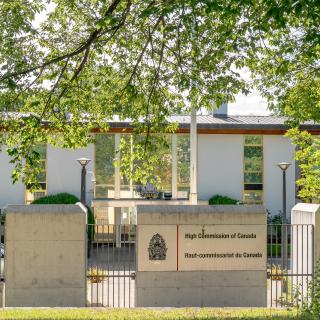
1. High Commission of Canada
150 Commonwealth Avenue
The High Commission of Canada’s striking architecture features red cedar eaves and is framed by two Canadian maple trees, symbols of Canada’s cultural identity and natural beauty.
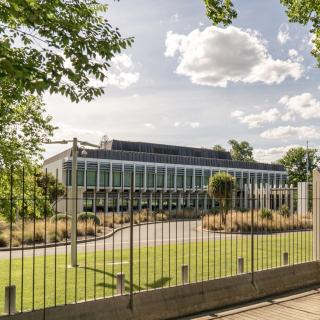
2. New Zealand High Commission
140 Commonwealth Avenue
The modern architecture seamlessly blends with native New Zealand materials to highlight the country’s commitment to sustainability and connection to nature. It features a resilient Kowhai tree as a symbol of New Zealand’s unique flora thriving in Canberra’s climate.
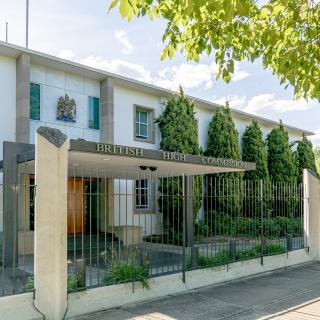
3. British High Commission
130 Commonwealth Avenue
Built in 1936 at a substantial cost of a quarter of a million pounds, Canberra’s first diplomatic legation, while perhaps appearing modest by today’s standards, was a marvel of its time.
4. Embassy of the People’s Republic of China
15 Coronation Drive
Opened in 1990, the Embassy grounds feature traditional gardens, a zigzag bridge, an ornamental lake, and beautiful rockeries highlighting China’s rich culture and artistry.

5. High Commission of Papua New Guinea
39 Forster Crescent
Marvel at the traditional Haus Tambaran, a sacred place for Sepik River communities, featuring totem poles decorated by students from the National Art School in Port Moresby, depicting clan ancestors.
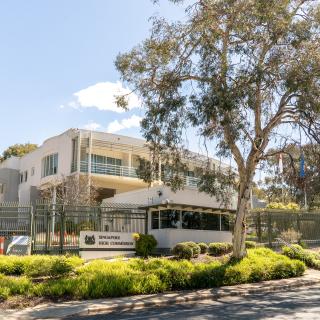
6. High Commission of the Republic of Singapore
17 Forster Crescent
The distinctive arc along the building’s first floor acknowledges Singapore’s equatorial location and adapts European building styles to the Singaporean climate with lattice sunshades, overhanging roofs, and verandas.
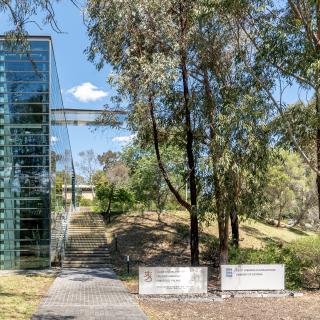
7. Embassy of Finland and Estonia
12 Darwin Avenue
The building’s layout is reminiscent of a ship, inspired by the legendary ship ‘Illmarinen’ which sunk in WWII. Included in the design is the traditional Finish sauna.
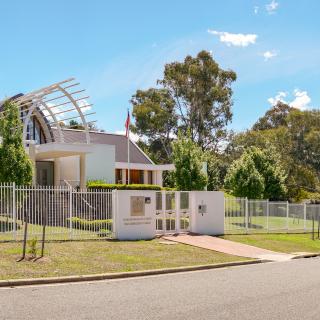
8. High Commission of the Independent State of Samoa
3 Darwin Avenue
The unique design, inspired by the traditional Samoan ‘Fale,’ features ‘afa’ lashing techniques in its construction, offering a glimpse into the communal and artistic traditions of Samoan culture.
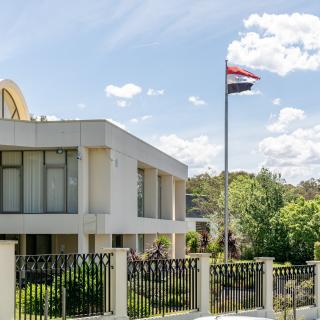
9. Embassy of the Arab Republic of Egypt
1 Darwin Avenue
The building’s design reflects contemporary Egypt, while the large barrel vault forming the entrance alludes to classic Egyptian architecture.
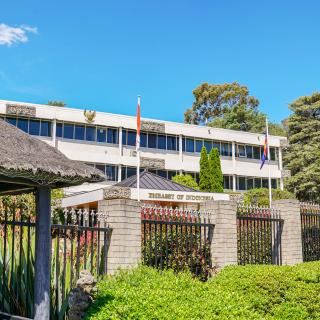
10. Embassy of the Republic of Indonesia
8 Darwin Avenue
The Wisma Wista Budaya, a traditional Javanese pendopo-style pavilion, is the first thing visitors see. Further in, intricate Balinese sculptures depict characters from the Hindu epics, Ramayana and Mahabharat, which have been adopted by the Indonesian people.
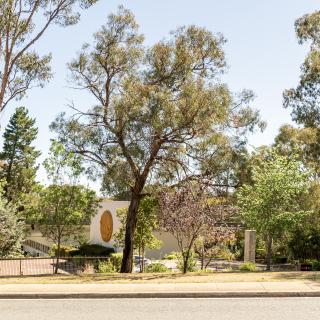
11. Embassy of Mexico
14 Perth Avenue
On either side of the wall on Perth Avenue are the Mexican national emblem and Aztec calendar. A distinctive interior feature is the model of Tenochtitlan, the Aztec capital.
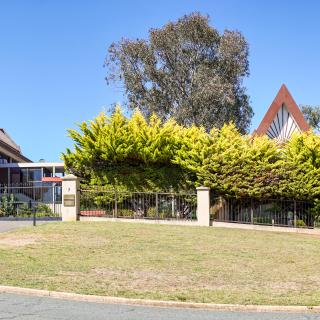
12. High Commission of Malaysia
7 Perth Avenue
The huge sweeping ‘Minangkabau’ roofs, the traditional ‘bunga raya’ flower motifs on the walls, and the marble -tiled foyer displays exquisite Malaysian crafts and Selangor pewter.
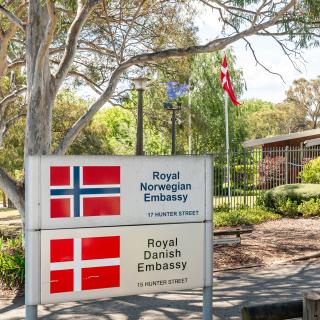
13. Embassies of Norway and Denmark
15-17 Hunter Street
The clever collaboration between Norway and Denmark highlights how countries can share resources and maintain cultural identities, offering insight into how diplomatic missions are able to adapt to practical necessity and foster international relations.
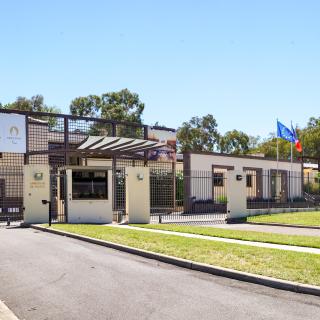
14. Embassy of France
6 Perth Avenue
Inspired by the French Foreign Legion, the embassy grounds feature a War Memorial, ‘Winged Victory’ sculpture, and gilded bronze pillar listing battles, serving as a poignant reminder of shared history and sacrifice between Australia and France.

15. High Commission of Pakistan
4 Perth Avenue
The Mughal architectural influence in the design evokes symmetry and balance, and a striking mural on the exterior wall celebrates Muhammad Ali Jinnah and Allama Iqbal.
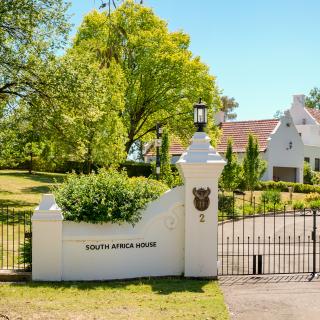
16. South African High Commission
2 Perth Avenue
The classic Cape Dutch architecture features whitewashed walls, small windows with teak shutters, a distinctive roof gable, and lush gardens of native South African plants. This combination offers a glimpse into the rich botanical heritage.
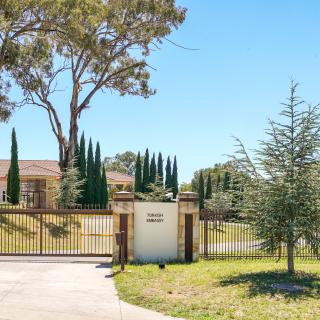
17. Embassy of the Republic of Türkiye
6 Moonah Place
Ottoman-inspired architecture highlights elongated windows and turret-like pillars, an ode to Ottoman ‘hisars’, while the gardens fuse Australian natives and traditional Ottoman designs, featuring 20,000 tulip bulbs in Spring.
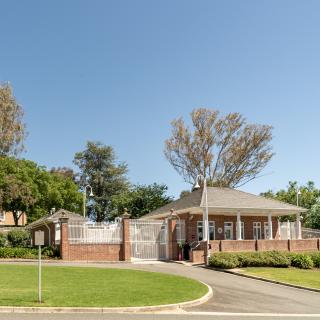
18. Embassy of the United States
of America
Moonah Place
The lease for this Embassy was signed on the day of the Pearl Harbour attack, and its architecture is inspired by Christopher Wren’s designs for Williamsburg, Virginia.
19. High Commission of India
3 Moonah Place
Characterised by mathematical symmetry and ornate decorations, the building highlights the grandeur of Mughal and Hindu architecture and features a serene, flowing moat from the entrance to Moonah Place.
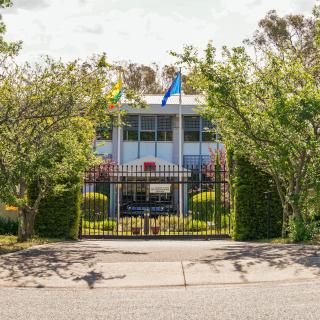
20. Embassy of the Republic of the Union of Myanmar
22 Arkana Street
The steel lattice work recalls the lattice screening of rural Myanmar houses, while the use of glass blends traditional design elements with modern architectural practices.

21. Royal Belgian Embassy
19 Arkana Street
The elegant Flemish architecture features soft apricot-painted brick and tall, teak mullioned windows beneath a gabled roof, evoking a touch of Flanders. Inside, bespoke furniture reflects Belgian craftsmanship and heritage.
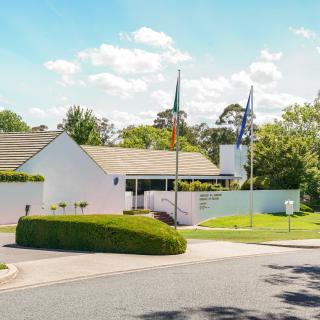
22. Embassy of Ireland
20 Arkana Street
The architecture, reminiscent of the charm of traditional Irish farm life, features whitewashed walls, steeply pitched roofs, and brick and tile accents, evoking a sense of comfort and rustic beauty.
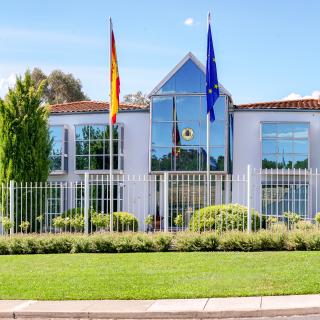
23. Embassy of Spain
15 Arkana Street
This Embassy’s patios with svelte columns echo the warmth of southern Spain, while the glass-covered balconies reflect northern traditions.
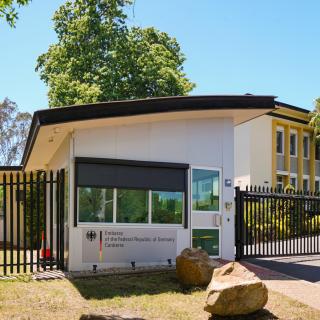
24. Embassy of the Federal Republic of Germany
119 Empire Circuit
The functionalist architecture of the German Embassy reflects the design trends of the 1950s and 1960s. The vibrant colours of the exterior, contrast with the lush greenery, creating a striking visual appeal.
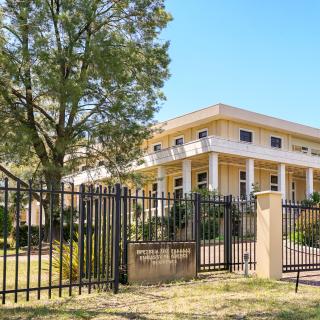
25. Embassy of Greece
9 Turrana Street
Experience the elegant columns, crafted from Pentelikon marble, and the serene central atrium. These elements reflect the enduring legacy of Greek architectural excellence.
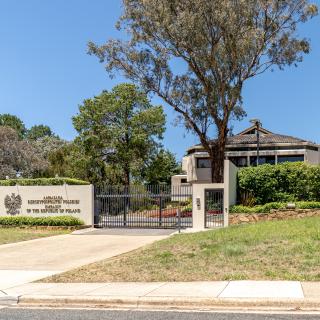
26. Embassy of the Republic of Poland
7 Turrana Street
The concrete and brick structure, topped with terracotta tiles, creates a bold and functional aesthetic. Step inside to experience the warm contrast of timber-lined ceilings and accents, adding a touch of elegance to the space.
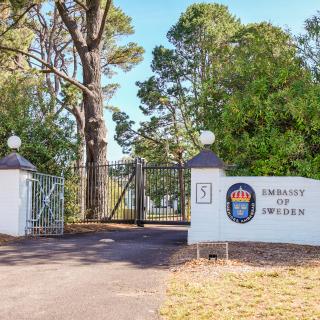
27. Embassy of Sweden
5 Turrana Street
Designed by Peddle Thorp & Walker alongside Swedish architect Edvard Lundquist, this building combines Swedish aesthetics with Canberra’s conditions. Awarded the Sir Sulman Award in 1952, it highlights masterful craftsmanship, featuring Swedish wood and Småland glass.
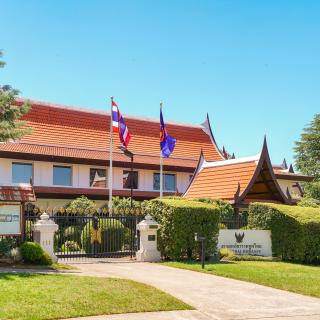
28. Royal Thai Embassy
111 Empire Circuit
Admire the distinctive lines and intricate details of the Royal Thai Embassy. The steeply pitched roofs and curved roof-ends reflect traditional Thai architectural styles, while the serene Sala Thai pavilion offers a tranquil space for cultural events.
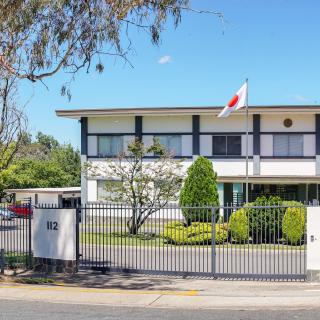
29. Embassy of Japan
112 Empire Circuit
The traditional wooden architecture, combined with the tranquil tea garden, creates a peaceful and contemplative atmosphere. This curated landscape, featuring a waterless garden, offers a unique and meditative experience.
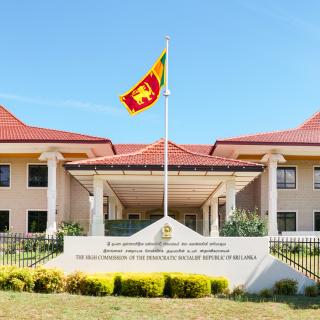
30. High Commission of the Democratic Socialist Republic of Sri Lanka
61 Hampton Circuit
With tropical modernism architecture, the vibrant red tiled roofs and uniquely decorated columns, topped with abstract capitals reminiscent of palm trees, blend traditional design with modern aesthetics.
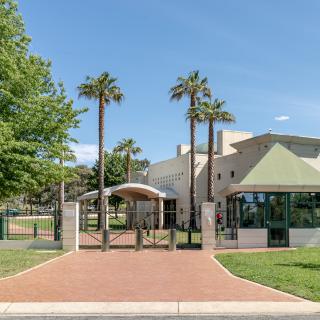
31. Royal Embassy of Saudi Arabia
38 Guilfoyle Street
Experience the grandeur of the Saudi Arabian Embassy, inspired by the Qasr Al Morabaa Palace. The central domed roof, a symbol of Islamic architecture, dominates the skyline.
Deakin
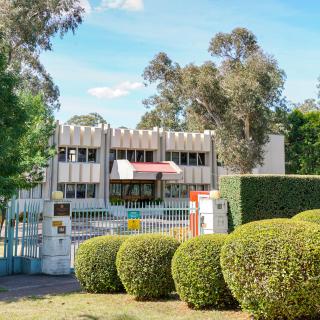
32. Embassy of Italy
12 Grey Street
Immerse yourself in the elegance of Italian architecture with the harmonious blend of Italian artistic heritage and the tranquil Australian environment, creating a stunning visual and cultural experience.
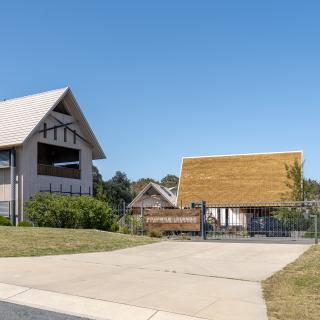
33. Solomon Islands High Commission
1 Beale Crescent
The contemporary design, inspired by traditional wooden architecture, reflects the country’s cultural heritage and connection to the Pacific Ocean. Exposed roof trusses, designed to withstand the fierce cyclones and storms common in the region, and a village-like courtyard with timber totems representing each of the nine provinces, offer a glimpse into Solomon Islander community and culture.
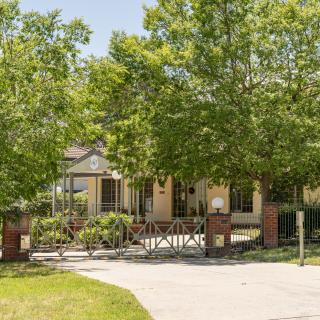
34. High Commission of the Republic of Mauritius
2 Beale Crescent
This embassy fuses French and Mauritian architectural styles, adapted for the tropical climate. Deep, sheltering eaves protect the building from the elements, while the single-story structure pays homage to the traditional ‘Case Creole’ style.
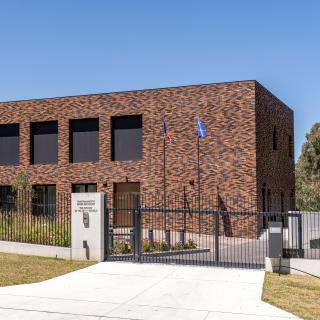
35. Embassy of the Czech Republic
3 Beale Crescent
The simple, solid structure with large brick openings reflects a unique and quintessentially Czech architectural approach. This modest yet functional design invites a deeper appreciation of Czech architectural ethos.
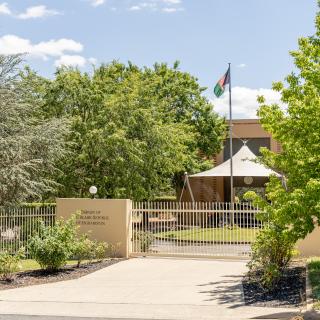
36. Embassy of the Islamic Republic of Afghanistan
4 Beale Crescent
The main façade is reminiscent of the grand city gates of Nineveh or Herat. With its intricate brick decorations, it offers a formal
welcome, while the central courtyard mirrors the communal heart of a traditional Afghan home. The rear, featuring a cluster of traditional mud homes complete with a watchtower, preserves the essence of Afghan architecture.
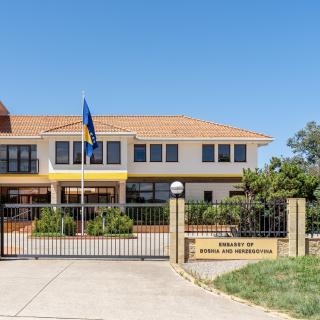
37. Embassy of Bosnia and Herzegovina
5 Beale Crescent
The elevated tower, reminiscent of traditional Bosnian watchtowers, adds a distinctive touch to the Embassy. The facade, with its coastal-inspired colours and materials, combined with traditionally styled Bosnian windows, reflects the country’s diverse heritage.
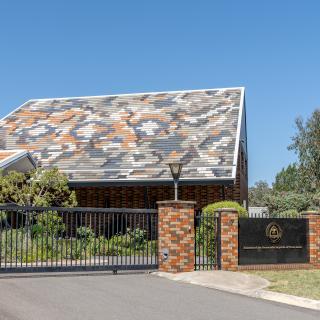
38. Embassy of the Democratic Republic of Timor-Leste
7 Beale Crescent
Admire the simple yet meaningful design inspired by affordable community housing from Timor-Leste. The vibrant roof, adorned with colours and patterns reminiscent of traditional Tais cloth, celebrates the country’s rich cultural heritage.
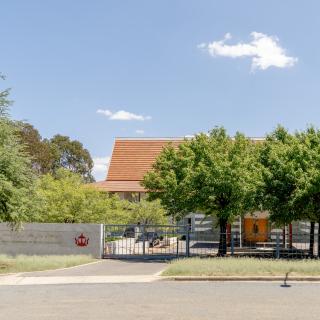
39. High Commission of Brunei Darussalam
10 Beale Crescent
Reminiscent of traditional Malay stilt houses, the raised building reflects Brunei’s historical connection to its aquatic surroundings.
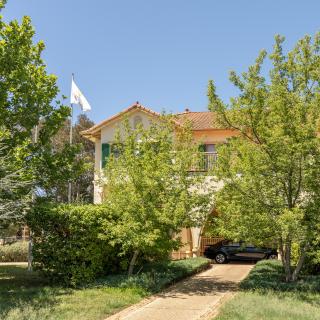
40. High Commission of the Republic of Cyprus
30 Beale Crescent
The distinctive pointed arches, representative of Byzantine influence, are unique to Cypriot architecture. The building incorporates a solarium and courtyards, offering shelter while allowing breezes to flow through. The shutters effectively block the sun, a necessary adaptation to Cyprus’s sunny climate.
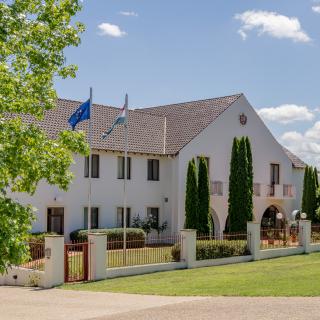
41. Embassy of Hungary
17 Beale Crescent
The arches, balconies, and planters echoing styles from various eras, combined with traditional red roofing tiles and a broad-pitched roof, evoke a sense of Hungarian heritage and hospitality.
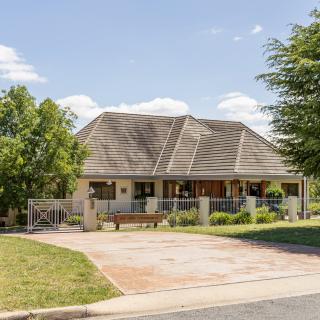
42. High Commission of the Republic of Fiji
19 Beale Crescent
Admire the unique architectural style of the Fijian High Commission, inspired by traditional ‘bure’ dwellings. The deeply pitched roof and round timber posts, adorned with tapa cloth patterns, reflect Fiji’s rich cultural heritage.
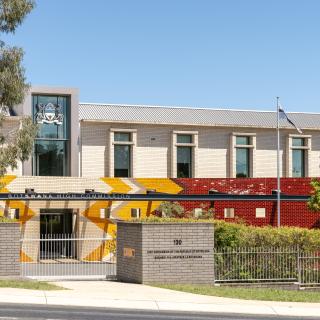
43. High Commission of the Republic of Botswana
130 Denison Street
While not adhering to traditional architectural styles, the High Commission features a striking entrance adorned with vibrant tiles arranged in patterns inspired by Botswana’s rich tradition in fabric, basketry, and pottery.
O'Malley
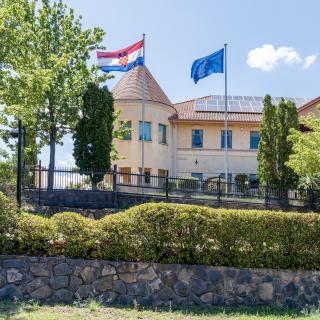
44. Embassy of the Republic of Croatia
14 Jindalee Crescent
The distinctive round tower, a modern nod to the Renaissance castles of Varaždin, and the vibrant roof tiles and soft hues of the walls evoke the picturesque Adriatic coast.

45. Embassy of the Lao People’s Democratic Republic
12 Jindalee Crescent
The high-pitched roofs and open courtyard spaces reflect the country’s cultural heritage and climate. The landscaped gardens, with their formal planting patterns, bring a touch of Laotian beauty to Canberra.
- Attractions
- Events
- Education
- Planning
- Planning in the National Capital
- Works Approval
- Heritage
- Heritage Strategy
- Heritage Management Plans
- ANZAC Parade Heritage Management Plan
- Acton Complex Draft Heritage Management Plan
- Australian American Memorial and Sir Thomas Blamey Square Heritage Management Plan
- Blundells Cottage Heritage Management Plan
- Changi Chapel Heritage Management Plan
- Commencement Column Monument HMP
- General Bridges Grave Heritage Management Plan
- High Court – National Gallery Precinct HMP
- King George V Memorial Heritage Management Plan
- Lake Burley Griffin and Adjacent Lands Heritage Management Plan
- National Carillon and Aspen Island Heritage Management Plan
- National Rose Gardens Heritage Management Plan
- Old Parliament House Gardens Heritage Management Plan
- Parliament House Vista Heritage Management Plan
- State Circle Cutting Heritage Management Plan
- Surveyors Hut and Surveyors Park Heritage Management Plan
- York Park Heritage Management Plan
- Heritage Management Plans under consultation
- Heritage Management Plans previous consultations
- Consultations
- Plans, policies and guidelines
- National Capital Plan
- Heritage Management Plans
- Planning Policy Review
- Urban design
- Acton Peninsula Precinct Structure Plan
- City and Gateway Urban Design Framework
- Constitution Avenue Public Realm Handbook
- Creating Places for People and Road User Hierarchy
- Deakin Forrest Residential Precinct Guidelines
- Guidelines for Commemorative Works in the National Capital
- Guidelines for Perimeter Security in the National Capital
- Outdoor Lighting Policy
- Parliamentary Zone Review
- The Griffin Legacy
- Tree Management Policy
- West Basin Precinct Guidelines
- Yarralumla Bay Recreational Hub Master Plan
- Your Capital, Your Say
- Environment
- National Land management
- Asset management
- Lake Burley Griffin
- NCA Projects
- Current NCA Projects
- Past NCA Projects
- Anzac Parade works
- Blundells Cottage Conservation and Interpretation Project
- Boundless Playground Picnic Deck
- Boundless parking extension
- Bowen Place Crossing
- Captain Cook Memorial Jet Upgrade Works
- Car Park Upgrades
- Commonwealth Park Lighting Replacement
- Dame Dorothy Tangney and Dame Enid Lyons Sculpture
- Draft Tree Management Policy
- Dunrossil Drive Pine Tree Replacement
- Furniture upgrade in Commonwealth Park
- High Mast Lighting
- International Flag Display Extension & Lighting Upgrade
- Interpretive Signage in the National Triangle
- John Gorton Building Car Park Upgrade & Associated Works
- John Gorton Building East Car Park Car Park Lighting Replacement Works
- King George V Memorial Works
- Kings Avenue Overpass
- Kings Park Improvements
- Lake Burley Griffin Wall Renewal Program
- Landscape Renewal at the Forecourt of the National Library of Australia
- Merchant Navy War Memorial Upgrade
- National Carillon Upgrade Works
- National Gallery of Australia Foreshore Upgrade
- Old Parliament House Gardens – rose name signage
- Regatta Point Redevelopment
- Restoration Works for the National Emergency Services Memorial
- Scrivener Dam Anchor Bolt Remediation
- Sir John Gorton Sculpture
- Sir John McEwen / National Party of Australia Centenary Commemoration
- Stirling Park improvements (Gura Bung Dhaura)
- Public Interest Certificates
- Parking
- About us
- Who we are
- Our Board
- Our Staff
- Volunteers
- Canberra National Memorials Committee
- History of the NCA
- 1913 - 1920 Walter Burley Griffin, Federal Capital Director of Design and Construction
- 1921 - 1924 Federal Capital Advisory Committee
- 1925 - 1930 Federal Capital Commission
- 1938 - 1957 National Capital Planning and Development Committee
- 1958 - 1989 National Capital Development Commission
- National Capital Planning Committee
- 1989 to Present Day National Capital Authority
- What we do
- Corporate documents
- Careers
- Key Governance Documents
- Video gallery
- Who we are
- Media centre
- Contact us
Acknowledgement of Country
We acknowledge the Ngunnawal people as traditional custodians of the ACT and recognise any other people or families with connection to the lands of the ACT and region.
We acknowledge and respect their continuing culture and the contribution they make to the life of this city and this region.
